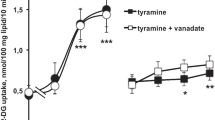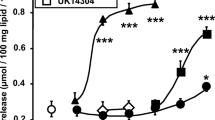Abstract
The antidepressant phenelzine is a monoamine oxidase inhibitor known to inhibit various other enzymes, among them semicarbazide-sensitive amine oxidase (currently named primary amine oxidase: SSAO/PrAO), absent from neurones but abundant in adipocytes. It has been reported that phenelzine inhibits adipocyte differentiation of cultured preadipocytes. To further explore the involved mechanisms, our aim was to study in vitro the acute effects of phenelzine on de novo lipogenesis in mature fat cells. Therefore, glucose uptake and incorporation into lipid were measured in mouse adipocytes in response to phenelzine, other hydrazine-based SSAO/PrAO-inhibitors, and reference agents. None of the inhibitors was able to impair the sevenfold activation of 2-deoxyglucose uptake induced by insulin. Phenelzine did not hamper the effect of lower doses of insulin. However, insulin-stimulated glucose incorporation into lipids was dose-dependently inhibited by phenelzine and pentamidine, but not by semicarbazide or BTT2052. In contrast, all these SSAO/PrAO inhibitors abolished the transport and lipogenesis stimulation induced by benzylamine. These data indicate that phenelzine does not inhibit glucose transport, the first step of lipogenesis, but inhibits at 100 μM the intracellular triacylglycerol assembly, consistently with its long-term anti-adipogenic effect and such rapid action was not found with all the hydrazine derivatives tested. Therefore, the alterations of body weight control consecutive to the use of this antidepressant drug might be not only related to central effects on food intake/energy expenditure, but could also depend on its direct action in adipocytes. Nonetheless, phenelzine antilipogenic action is not merely dependent on SSAO/PrAO inhibition.



Similar content being viewed by others
References
Al-Nuaimi SK, Mackenzie EM, Baker GB (2012) Monoamine oxidase inhibitors and neuroprotection: A Review. Am J Ther 19(6):436–448
Andree TH, Clarke DE (1982) Characteristics and specificity of phenelzine and benserazide as inhibitors of benzylamine oxidase and monoamine oxidase. Biochem Pharmacol 31:825–830
Atgié C, Sauvant P, Ambid L, Carpéné C (2009a) Possible mechanisms of weight loss of Siberian hamsters (Phodopus sungorus sungorus) exposed to short photoperiod. J Physiol Biochem 65:377–386
Atgié C, Hadj-Sassi L, Bukowiecki L, Mauriège P (2009b) High lipolytic activity and dyslipidemia in a spontaneous hypertensive/NIH corpulent (SHR/N-cp) rat: a genetic model of obesity and type 2 diabetes mellitus. J Physiol Biochem 65:33–42
Beier RC (1990) Natural pesticides and bioactive components in foods. Rev Environ Contam Toxicol 113:47–137
Bour S, Prévot D, Guigné C, Stolen C, Jalkanen S, Valet P, Carpéné C (2007) Semicarbazide-sensitive amine oxidase substrates fail to induce insulin-like effects in fat cells from AOC3 knockout mice. J Neural Transm 114:829–833
Boyce S, Tipton KF, O’Sullivan MI, Davey GP, Gildea MM, McDonald AG, Olivieri A, O’Sullivan J (2009) Nomenclature and potential functions of copper amine oxidases. In: Floris G, Mondovi B (eds) Copper amine oxidases: structures, catalytic mechanisms and role in pathophysiology. CRC Press, Boca Raton, pp 5–18
Carpéné C, Fontana E, Morin N, Visentin V, Prévot D, Castan I (2001) Substrates of semicarbazide-sensitive amine oxidase mimic diverse insulin effects in adipocytes. Inflamm Res 50:142–143
Carpéné C, Iffiú-Soltesz Z, Bour S, Prévot D, Valet P (2007) Reduction of fat deposition by combined inhibition of monoamine oxidases and semicarbazide-sensitive amine oxidases in obese Zucker rats. Pharmacol Res 56:522–530
Carpéné C, Abello V, Iffiú-Soltész Z, Mercier N, Fève B, Valet P (2008) Limitation of adipose tissue enlargement in rats chronically treated with semicarbazide-sensitive amine oxidase and monoamine oxidase inhibitors. Pharmacol Res 57:426–434
Carpéné C, Balogh B, Mercader J, Brea J, Gomez-Ruiz A, Dunkel P, Matyus P, Loza MI (2011) Direct inhibitory effect of phenelzine on human primary amine oxidase, an enzyme formerly known as SSAO/VAP-1. In: Vas A (ed) Medimond international proceedings: tenth congress of the european association for clinical and pharmacology and therapeutics, pp 77–83
Carroll JF, King JW, Cohen JS (2004) Hydralazine treatment alters body composition in the rabbit model of obesity. Acta Physiol Scand 181:183–191
Castillo V, Lizcano JM, Unzeta M (1999) Presence of SSAO in human and bovine meninges and microvessels. Neurobiology 7:263–272
Chiche F, Le Guillou M, Chetrite G, Lasnier F, Dugail I, Carpéné C, Moldes M, Fève B (2009) The antidepressant phenelzine alters differentiation of cultured human and mouse preadipocytes. Mol Pharmacol 75:1052–1061
Dyck LE, Juorio AV, Boulton AA (1982) The in vitro release of endogenous m-tyramine, p-tyramine and dopamine from rat striatum. Neurochem Res 7:705–716
Edwards S, Lalor PF, Nash GB, Rainger GE, Adams DH (2005) Lymphocyte traffic through sinusoidal endothelial cells is regulated by hepatocytes. Hepatology 41:451–459
Enzsöly A, Dunkel P, Récsan Z, Gyorffy H, Toth J, Marics G, Bori Z, Toth M, Zelko R, Di Paolo ML, Matyus P, Nemeth J (2011) Preliminary studies of the effects of vascular adhesion protein-1 inhibitors on experimental corneal neovascularization. J Neural Transm 118:1065–1069
Hemmrich K, Thomas GPL, Abberton KM, Thompson EW, Rophael JA, Penington AJ, Morrison WA (2007) Monocyte chemoattractant protein-1 and nitric oxide promote adipogenesis in a model that mimics obesity. Obesity 15:2951–2957
Iffiú-Soltész Z, Mercader J, Daviaud D, Boucher J, Carpéné C (2011) Increased primary amine oxidase expression and activity in white adipose tissue of obese and diabetic db-/- mice. J Neural Transm 118:1071–1077
Iglesias-Osma MC, Bour S, Garcia-Barrado MJ, Visentin V, Pastor MF, Testar X, Marti L, Enrique-Tarancon G, Valet P, Moratinos J, Carpéné C (2005) Methylamine but not mafenide mimics insulin-like activity of the semicarbazide-sensitive amine oxidase-substrate benzylamine on glucose tolerance and on human adipocyte metabolism. Pharmacol Res 52:475–484
Koskinen K, Nevalainen S, Karikoski M, Vainio PJ, Hänninen A, Jalkanen S, Salmi M (2007) VAP-1-deficient mice display defects in mucosal immunity and antimicrobial responses: implications for antiadhesive applications. J Immunol 179:6160–6168
Langford SD, Trent MB, Boor PJ (2001) Cultured rat vascular smooth muscle cells are resistant to methylamine toxicity: no correlation to semicarbazide-sensitive amine oxidase. Cardiovasc Toxicol 1:51–60
MacKenzie EM, Grant SL, Baker GB, Wood PL (2008) Phenelzine causes an increase in brain ornithine that is prevented by prior monoamine oxidase inhibition. Neurochem Res 33:430–436
MacKenzie EM, Song M-S, Dursun SM, Tomlinson S, Todd KG, Baker GB (2010) Phenelzine: an old drug that may hold clues to the development of new neuroprotective agents. Bull Clin Psychopharmacol 20:179–186
Marttila-Ichihara F, Smith DJ, Stolen C, Yegutkin GG, Elima K, Mercier N, Kiviranta R, Pihlavisto M, Alaranta S, Pentikainen U, Pentikainen O, Fulop F, Jalkanen S, Salmi M (2006) Vascular amine oxidases are needed for leukocyte extravasation into inflamed joints in vivo. Arthritis Rheum 54:2852–2862
Mercader J, Iffiú-Soltesz Z, Brenachot X, Földi A, Dunkel P, Balogh B, Attané C, Valet P, Mátyus P, Carpéné C (2010) SSAO substrates exhibiting insulin-like effects in adipocytes as a promising treatment option for metabolic disorders. Future Med Chem 2:1735–1749
Mercader J, Iffiú-Soltész Z, Bour S, Carpéné C (2011) Oral administration of semicarbazide limits weight gain together with inhibition of fat deposition and of primary amine oxidase activity in adipose tissue. J Obes 2011:475786
Mercier N, Kakou A, Challande P, Lacolley P, Osborne-Pellegrin M (2009) Comparison of the effects of semicarbazide and β-aminopropionitrile on the arterial extracellular matrix in the Brown Norway rat. Toxicol Appl Pharmacol 239:258–267
Moldes M, Fève B, Pairault J (1999) Molecular cloning of a major mRNA species in murine 3T3 adipocyte lineage. Differentiation-dependent expression, regulation, and identification as semicarbazide-sensitive amine oxidase. J Biol Chem 274:9515–9523
Moody AJ, Stan MA, Stan M, Gliemann J (1974) A simple free fat cell bioassay for insulin. Horm Metab Res 6:12–16
Morin N, Lizcano JM, Fontana E, Marti L, Smih F, Rouet P, Prévot D, Zorzano A, Unzeta M, Carpéné C (2001) Semicarbazide-sensitive amine oxidase substrates stimulate glucose transport and inhibit lipolysis in human adipocytes. J Pharmacol Exp Ther 297:563–572
Olivieri A, Rico D, Khiari Z, Henehan G, O’Sullivan J, Tipton K (2011) From caffeine to fish waste: amine compounds present in food and drugs and their interactions with primary amine oxidase. J Neural Transm 118:1079–1089
Parent MB, Habib MK, Baker GB (2000) Time-dependent changes in brain monoamine oxidase activity and in brain levels of monoamines and amino acids following acute administration of the antidepressant/antipanic drug phenelzine. Biochem Pharmacol 59:1253–1263
Prévot D, Soltesz Z, Abello V, Wanecq E, Valet P, Unzeta M, Carpéné C (2007) Prolonged treatment with aminoguanidine strongly inhibits adipocyte semicarbazide-sensitive amine oxidase and slightly reduces fat deposition in obese Zucker rats. Pharmacol Res 56:70–79
Salmi M, Yegutkin GG, Lehvonen R, Koskinen K, Salminen T, Jalkanen S (2001) A cell surface amine oxidase directly controls lymphocyte migration. Immunity 14:265–276
Schwelberger HG (2007) The origin of mammalian plasma amine oxidases. J Neural Transm 114:757–762
Todd KG, Baker GB (2008) Neurochemical effects of the monoamine oxidase inhibitor phenelzine on brain GABA and alanine: a comparison with vigabatrin. J Pharm Pharm Sci 11:14s–21s
Unzeta M, Solé M, Boada M, Hernández M (2007) Semicarbazide-sensitive amine oxidase (SSAO) and its possible contribution to vascular damage in Alzheimer’s disease. J Neural Transm 114:857–862
Yan H, Aziz E, Shillabeer G, Wong A, Shanghavi D, Kermouni A, Abdel-Hafez M, Lau DC (2002) Nitric oxide promotes differentiation of rat white preadipocytes in culture. J Lipid Res 43:2123–2129
Acknowledgments
The authors express gratitude to all the staff of the Animal Unit of I2MC, presently called US006 CREFRE (Toulouse, France). They also thank Phil Valet, Sarah Canteiro, Saioa Gomez and Josep Mercader (Inserm U1048, Toulouse) for help in discussion and in data collection. David Smith (Biotie Therapies, Finland) is thanked for kindly giving BTT2052. Work partly supported by DIOMED project (SUDOE 1/P1/E178).
Author information
Authors and Affiliations
Corresponding author
Rights and permissions
About this article
Cite this article
Carpéné, C., Grès, S. & Rascalou, S. The amine oxidase inhibitor phenelzine limits lipogenesis in adipocytes without inhibiting insulin action on glucose uptake. J Neural Transm 120, 997–1003 (2013). https://doi.org/10.1007/s00702-012-0951-3
Received:
Accepted:
Published:
Issue Date:
DOI: https://doi.org/10.1007/s00702-012-0951-3




